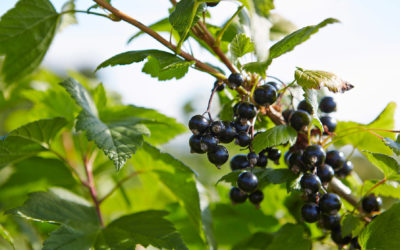A Year As A Blackcurrant Grower

Looking to grow your own blackcurrants? If so, we’ve broken your blackcurrant-growing journey down into three simple steps and shared our top tips to see you from one start of the year to another…
Planting
Blackcurrant plants are typically sold as two-year-old bushes, and the months of November, December, January, February and March are the best time to plant these in the ground; this is known as the ‘dormant’ season. It’s best to avoid planting in the middle of winter when the ground can be too wet or frozen. Blackcurrant plants prefer full sun but will cope with light shade. The plants are sensitive to frost, so avoid planting in drafty areas, as cold winds and late frosts can damage flowers and reduce the crop.
If you have space to plant several plants, we’d suggest selective varieties that produce fruit from the early to late season to ensure a fruitful harvest for most of the summer.
Our growers plant blackcurrant cuttings into the ground – but it will take three years for these to produce their first proper crop for Ribena.
Harvesting
When your blackcurrants are big, shiny, and dark purple, they’re ready to pick! Harvest your crops on a dry day, as wet blackcurrants can spoil quickly. Once picked, your blackcurrants will keep in the fridge for several days. Take a look at our recipe for some delicious fruity inspiration.
If you’re looking to freeze your blackcurrant to enjoy later in the year, we’d recommend freezing them on a baking tray so they freeze individually before adding them into a freezer bag. This makes them much easier to grab a handful rather than having to defrost all the fruit that is stuck together.
Depending on the variety, your blackcurrants will be ready for harvesting from early summer onwards. The Blackcurrant Foundation harvest starts mid-July, typically in Kent, and ends mid-August in Dundee, Scotland.
Maintenance
Once the harvest is over, your bushes will need maintenance to ensure a healthy crop next year. To encourage new stems to grow, the bushes will need pruning annually in winter. If you’ve had strong growth, we recommend pruning lightly, whereas if growth has been weak, then a hard prune is better – cut at least half the shoots back near ground level.
When spring comes back around, the great British weather can still be unpredictable. Any late frosts can be very damaging to the overall yield of the bush. Once the bush has flowered, the flowers are incredibly delicate. Frosts can cause the flowers to fall off, and one flower = one blackcurrant! On nights when frost is forecast, it’s good to be prepared and protect bushes in flower by covering them with a fleece or cloth.
We’d love to see how you get on growing your own and the delicious ways you choose to enjoy your crops once they’re ready! Follow us on Instagram, and don’t forget to tag us in your photos – @ukblackcurrants.
YOU MAY ALSO WANT TO READ
It’s all about Ribena!
If you think about blackcurrants, you’ll instantly think, Ribena. It’s not surprising, considering that 90% of the UK’s crop goes into that distinctive, ‘Ribenary’ taste. Where did it all begin? Ribena was invented in 1938. The first drink of its kind,...
Enjoy summer with blackcurrants…
Make the most of blackcurrant season this summer Great British Summertime is blackcurrant season. It’s short and sweet, so make sure you enjoy everyone’s favourite purple berries while you can. Here are some of our favourite ways to incorporate blackcurrants...
How to Get Involved in Blackcurrant Day
Blackcurrant Day 2022: We’re ‘berry’ excited! You’ll know by now that we’re bonkers about blackcurrants at The Blackcurrant Foundation. Last year, we took it upon ourselves to celebrate those little purple powerhouses with a national day...




